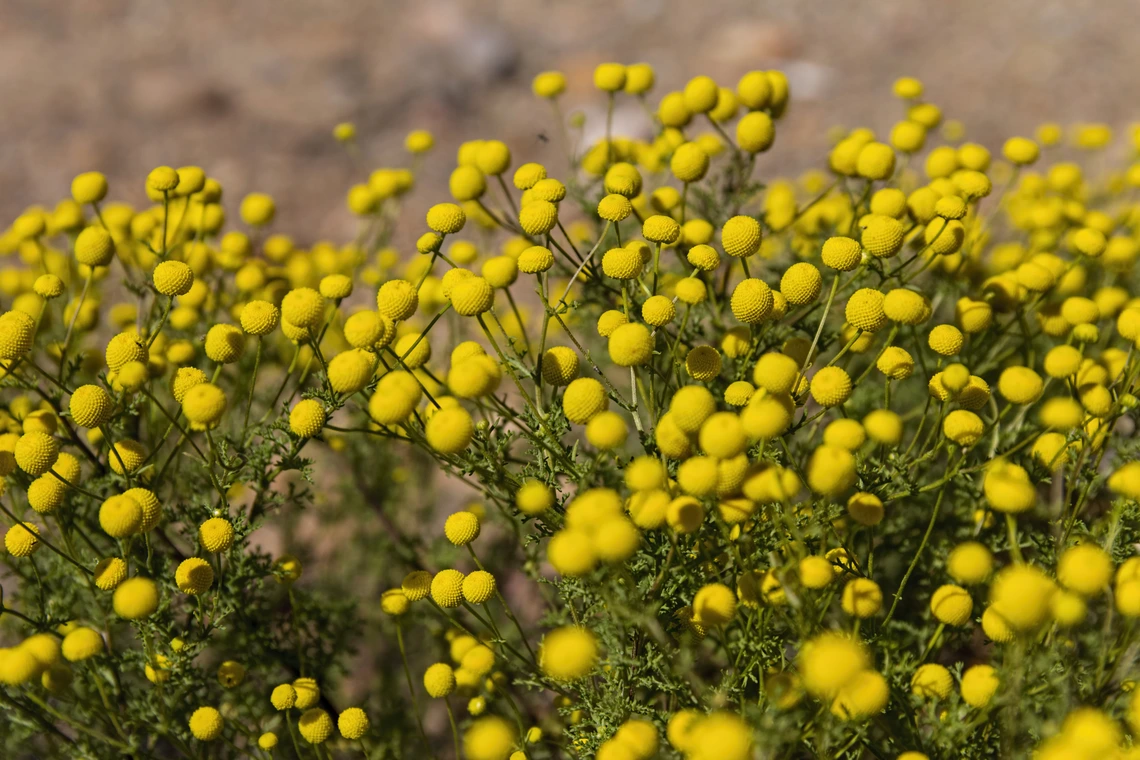Spring into Action Against Invasive Species

Stinknet is a new invasive species of particular concern in Arizona. If you see stinknet in your neighborhood, report the sighting at stinknet.org.
As the spring season comes to a close and the monsoon looms on the horizon, the desert has come back to life. However, mixed into the native cacti are non-native – and increasingly prevalent – invasive species that impact the ecological balance and threaten the unique biodiversity of the Sonoran Desert Ecosystem.
Invasive species are becoming an increasingly serious issue as Arizona feels the impacts of climate change. This concern raises the question: Which invasive species should we be watching out for, and how can we effectively manage them?

Theresa Crimmins, School of Natural Resources and the Environment Associate Professor and USA National Phenology Network
Though encountering these species may seem daunting, effective management strategies are within reach, said School of Natural Resources and the Environment Associate Professor and USA National Phenology Network Director Theresa Crimmins.
Arizona’s most acknowledged invasive species, buffelgrass, has continued to persist throughout the years.
Introduced in the early 1900s to feed cattle, it has since spread extensively across low-elevation desert landscapes. Buffelgrass’ high biomass accumulation makes it highly flammable when dry, and during hot, dry conditions, as Arizona regularly experiences, buffelgrass can fuel fires through non-fire-adapted landscapes like the Sonoran Desert, leading to devastating consequences.
Probably anyone who's lived in southern Arizona for any length of time is familiar with goat head, more widely known as puncture vine (Tribulus Terrestris), as when dried, the plant develops hard, spiky seeds that can puncture the bottom of your shoes, bike tires, and more.
Morning Glories are another plant that often comes up in conversations about harmful invasive species. Though charming with their trumpet-shaped blooms, they can become problematic due to their dense tangly vines, which compete with and “choke out” other beneficial plants.
However, Arizona actually has many native morning glories that are a part of the natural ecosystem, said Assistant Agent for Urban Horticulture with the University of Arizona Maricopa County Cooperative Extension Michael Chamberland. It is only certain kinds including introduced species that present issues, such as when they are twined around crops, hampering mechanical harvesting, he said.
These invasive species pose challenges to management efforts.
“Take buffelgrass, for instance — it requires persistent efforts due to its rapid and extensive spread. We're often playing catch-up in our attempts to control it,” said Crimmins
Thankfully, groups like the Sonoran Desert Weed Wackers and the Sonoran Desert Cooperative Weed Management Area are dedicated to trying to manage these problems locally.
“There are definitely people putting their efforts together and trying to pull them in the same direction,” said Crimmins
Recognizing the importance of early detection and rapid response for minimizing the spread of these species, Crimmins’ involvement with the Phenology Network supports ongoing efforts to learn how changes in climate relate to the prevalence of invasive species and their management.
The network offers a series of products called Pheno Forecasts, including Buffelgrass Green-up Maps that predict buffelgrass readiness for herbicide treatment based on recent rainfall. This real-time information assists management agencies in determining the most effective locations for intervention, maximizing the impact of their efforts.
“There are definitely people putting their efforts together and trying to pull them in the same direction.”
– Theresa Crimmins
The weed Stinknet has been making headlines recently due to its rapid spread and invasive nature, becoming a concern in several regions across the globe. “Stinknet is the new bully on the block,” said Chamberland.
Originally from South Africa, Stinknet initially showed up as a weed in Southern California, though the cause of its emergence is uncertain. It quickly took hold in Phoenix, spreading easily through its tiny seeds carried by people and pets and popping up anywhere from cracks in the sidewalk to yards and gardens. Now, it’s hitching rides across state and national borders, spreading throughout Tucson, California, Nevada, and Mexico.
“This issue has been historically overlooked compared to buffelgrass, despite stinknet's increasing prevalence on the landscape” Michael Chamberland
Stinknet is a winter annual, growing during winter with rainfall, flowering in March or April, and then dying, Chamberland said. It also capitalizes on fire-prone areas, leaving seeds in flammable dry plants that post-burn leave behind ashy material that's a perfect spot for stinknet to grow.
In addition to its environmental impacts, stinknet is considered a noxious weed and can trigger allergic reactions, especially among those who are engaged in actively removing it, Chamberland said.
“The professionals who are going out and trying to treat stinknet out across large areas are putting themselves in the thick of it,” Chamberland said. “Fortunately, Tucson is more prepared due to Phoenix's experience. Various groups in Tucson like the Audubon Society and public land managers actively combat stinknet, a progress seen since 2019 when it was relatively unknown.”
Michael Chamberland and the Maricopa Cooperative Extension have worked intensely to research stinknet, offering insights into the characteristics of the weed and how to approach its management.

Michael Chamberland, Assistant Agent for Urban Horticulture with the University of Arizona Maricopa County Cooperative Extension
When discussing the effects of climate change on species dynamics like distribution and spread, Crimmins notes that warmer winter and spring temperatures can lead to an earlier start to the growing season.
“What this means for invasive species is that an earlier spring provides an opportunity to become established earlier in the season, and those able to handle these increasingly extreme conditions might outcompete native plants who aren’t adapted to the changing climate,” Crimmins said.
In the Sonoran Desert, where plant growth at low elevations is constrained more by moisture than temperature, warmer weather that expedites the start of the growing season doesn't necessarily mean it'll be longer; it might just begin earlier.
White lead tree (Leucaena leucocephala) is one such species taking advantage of climate change’s impacts in Tucson, Chamberland said. The weedy tree has established itself in Phoenix, but has historically struggled to take root in Tucson, likely because the area has regular hard freezes in the winter. However, over the last decade, milder winters in Tucson have enabled the white lead tree to become more established and reach reproductive size in parts of the city, Chamberland said.
Anyone who comes across these species is encouraged to appropriately uproot and discard them, though both Crimmins and Chamberland said to be cautious when handling seeding plants, as pulling them may risk spreading more seeds. To contain this, one method is to cover the plant with a plastic bag before removing it, ensuring all seeds are contained. The uprooted plant material is best disposed of by throwing it away, such as in a landfill.
In terms of managing stinknet, those who find stinknet on their own land are encouraged to uproot/kill it, though if seen on land that does not belong to you, contact the land manager, or report sightings to Stinknet.org, where you can find photos to help accurately identify stinknet and distinguish it from some plants it could be confused with, Chamberland recommends.
“It's certainly not hopeless, but it does require that we pay attention to what we're doing and try to take action where we can,” said Crimmins
